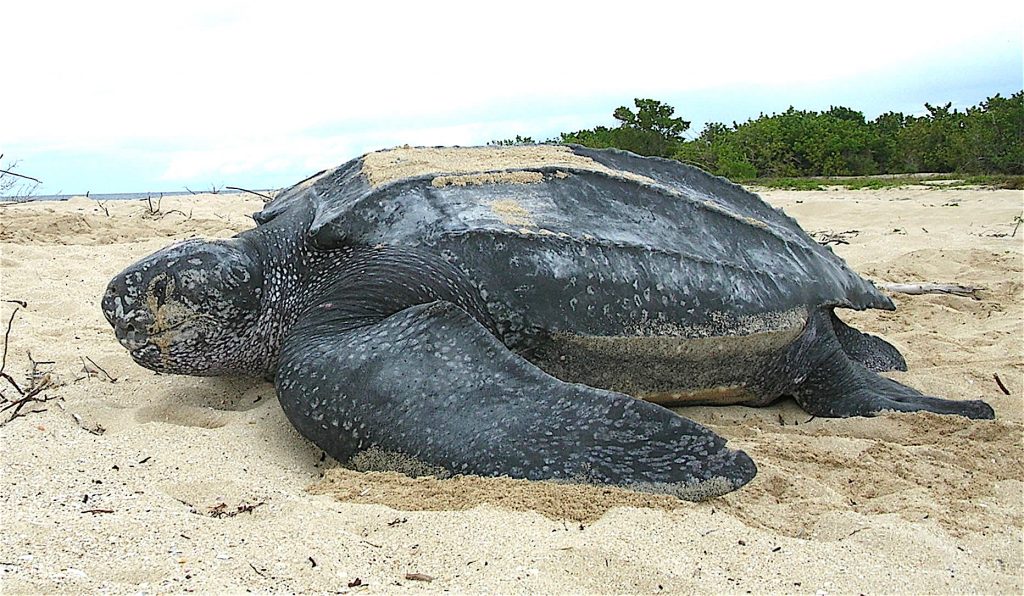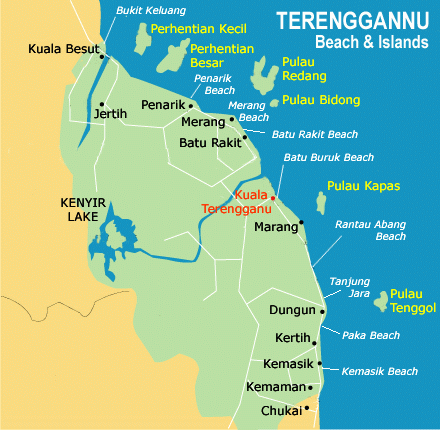
The Rantau Abang beach in the state of Terengganu, Malaysia , is one of the few places on earth that the giant leatherback turtles (leatherbacks) choose to come ashore to nest. Once, they helped put this normally quiet small village on the world map. Tourists, foreign and domestic as well as locals flocked by the thousands to this village to watch the leatherbacks come to nest and lay eggs on its beach between the months of March and October. It once had the largest nesting population in the world, hosting 10,000 nests per year.

Leatherbacks’ Facts
The Leatherbacks (Dermochelys Coriacea or Penyu Belimbing to locals) are both the largest sea turtles and the oldest living reptiles. Leatherbacks can live to 50 years or more. Male leatherbacks can reach up to 2.6 metres in length and weigh 900 kg.
A leatherback is easily distinguishable by its leathery soft shell or carapace, and by its long front flippers. Seven ridges run down the length of its white spotted carapace. All other species of turtles have hard shells. Leatherbacks are found in all of the world’s oceans except the Arctic and the Antarctic. Females spend their entire lives at sea except to nest, while males never left the water.
Leatherbacks and other turtles play an important role in the marine ecosystem. They feed on jellyfish and help check its population. The leatherback’s extra-long esophagus is lined with spines to facilitate digestion of jellyfish. Leatherbacks lay eggs on dry, sandy, tropical or subtropical beaches. They lay between two and six clutches of eggs in a single nesting season. Each clutch contains 65 to 180 eggs and is laid approximately every two weeks. Incubation takes about 60 days. As with other reptiles, the temperature during incubation will determine the sex of the turtles. For leatherbacks, temperatures above 29 degrees centigrade will result in female hatchlings. Hatchlings or baby leatherbacks are not cared for by the adults and are left to fend for themselves. The young ones that survive stay back in tropical waters until maturity. It takes 15 – 20 years for them to reach breeding age and become adults and then began their oceanic migratory journeys.
Adult leatherbacks prey on jellyfish and subsist almost entirely on them. They migrate thousands of miles in their lifetimes through ocean basins and high seas for the purpose. Migration occurs between the cold waters where mature leatherbacks feed, to the tropical and subtropical beaches in the regions where they hatch. These great swimmers complete their marathon journeys normally every 2 to 3 years to return to the same breeding grounds to nest. They can also dive much deeper than any other marine turtles. The deepest dive recorded was 1,230 meters
Odds Stacked Against Survival
Female leatherbacks lay hundreds of eggs each nesting season. Sadly however, very few of these hatchlings survive into their first year. They are very vulnerable to become prey to crabs, monitor lizards and birds while on their way out to sea, soon after hatching. In the shallow waters, many more hatchlings are eaten by fish. Only about 6% of these young leatherbacks survive their first year. Over the next 15 – 20 years more mortality among these young leatherbacks will reduce their survival rate further. And their chances of becoming adults and to regenerate will slide as well. Getting caught in trawling activities as well as succumbing to predators such as sharks are reasons for increase mortality among young and adult leatherbacks alike. Mistakenly consuming plastic bags floating in the seas and oceans as jellyfish is another contributing factor as well.
Why the Steep Drop in Nesting Numbers?
Globally, the leatherbacks are now classified as endangered while in Malaysia, where the situation is much worse; it is classified as critically endangered. Nowadays very few of these graceful leatherheads return to Rantau Abang to nest. Where 10,000 nesting was recorded in the 1950s, this had dropped to fewer than 10 nesting by 1999 and just 2 in 2008 and 2010. There was only a solitary nesting in 2017.
Poaching and human consumption of the leatherbacks’ eggs are often cited as the most significant factor for the species decline. Gross abuses towards the leatherbacks by the locals and tourists during nesting and when returning to sea, most likely discourage the leatherbacks from returning to nest. They were trapped in net by trawling activities, and these further add to this dwindling population of leatherbacks coming to nest. Mortality due to ingestion of floating marine debris like discarded plastic bags which resemble their favourite prey, jellyfish is also a contributing factor. Ineffective conservation efforts initiated in the 1960s had not helped either as exposure of the eggs to high temperatures inadvertently results in only female hatchlings.
The Department of Fisheries Malaysia (The Department) now has a Turtle Information Centre at Rantau Abang. Besides disseminating information concerning turtles; the Centre and the Department are also involved in conservation efforts: Rangers are patrolling the beaches to protect the turtles and their eggs from poachers when they come ashore to nest. Collection (except by licensed turtle egg collectors) or eating of turtle eggs are forbidden.
The Rantau Abang Fisheries Protected Area was established in 1991 covering the entire 30km beach and extends 18.5km out to sea. Gill nets of a mesh size 25.4cm, which killed up to 400 turtles a year, were subsequently banned from Malaysian waters altogether. The department is now enforcing these requirements and protective measures.
The Department is continuing and improving on its hatchery activities in its efforts to help increase the turtle population, particularly the leatherbacks
Will these giant leatherbacks make a come-back to Rantau Abang?
Rantau Abang is now returning to its quiet days of old – no more bustling with tourists as it used to be. And the reason is due to the dwindling number of turtles coming to nest at its beach, especially the leatherbacks. Given its relatively unspoiled and undisturbed stretch of beach, Rantau Abang is thought as the right place for leatherbacks to come to nest. The beach terrain is favorable. Its soft sandy beach is steep and is close to vegetation allowing the leatherbacks to quickly find suitable nesting spots – just a short crawl from the water edge. Minus the crowd of turtle watches and their attendant disturbing antics of old, the place would be ideal for the leatherbacks to return and nest again. So given time, these giants of all turtles might just come back more often. But for how soon I’m not willing to guess.
Dato’ Dr Anuar’s Comment
The lesson for Rantau Abang is that it is costly for the folks of the town and Terengganu as a whole. By selling eggs of the leatherbacks continuously over many years for a fistful of RM, the town lost its important economic assets that come onshore voluntarily. Consuming the eggs means that future generation of leatherbacks is gone forever.
About the guest contributor:
Mr Ahmad Rozi Daud is a stingless bee farmer in Kuala Terenganu, Malaysia. He resides near Rantau Abang, Terengganu . He also provides training for those who are interested to be a stingless beekeeper or apiarist. Please contact us at 6016 3220 952 for assessment of suitability of your location for stingless bee farming.